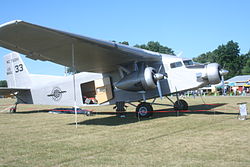Aircraft Hydro-Forming Bushmaster 2000
| Aircraft Hydro-Forming Bushmaster-2000 | |
|---|---|

|
|
| Type: | Airliner |
| Design country: | |
| Manufacturer: |
Aircraft Hydro-Forming |
| First flight: |
August 1966 |
| Production time: |
1966-1985 |
| Number of pieces: |
2 |
The Aircraft Hydro-Forming Bushmaster 2000 was an airliner from the 1960s, originally manufactured by the Hayden Aircraft Corporation . With the model an attempt was made to revive the concept of the Ford Trimotor .
history
William Bushnell Stout , the designer of the first Trimotor variant, and his partner Robert Hayden suggested that this robust and reliable model should be re-produced in a modernized form as a means of transport for remote and otherwise inaccessible areas. In addition to the installation of modern engines, the fuselage should be widened to accommodate the new freight container. For production, the Hayden Aircraft Corporation was launched on January 15, 1955 in California . Stout was the technical director, the other members of an advisory board for the company were George Otto Noville and Gene May , a former test pilot at Douglas.
Due to the tight financial framework of the company, many of the originally planned modifications could not be made. A demand survey in Alaska, Canada and Australia showed that the production of a prototype and 99 series aircraft would enable economical production. However, it took 11 ½ years from the company's foundation to the construction of the first Bushmaster aircraft, which could be flown in August 1966. In 1966, the construction of around 1000 machines was planned. Due to financial and other problems, however, it did not come to that.
It even took 30 years until the first launch of the second model in 1985. The prototype with the registration number N7501V is now part of the holdings of the Golden Wings Flying Museum in Minneapolis , which is maintained by Greg Herrick. The second machine, registered N750RW, had a number of different owners. It crashed on September 25, 2004 when taking off for a workshop flight in Fullerton (California) and had to be written off. A third cell was never completed and is located in a trailer park in Arizona.
Designations
The first prototype was called the Stout Bushmaster in 1966 , which then became the Hayden Bushmaster 15-AT , a continuation of the original system used by Ford for the Trimotor. The last name there was 14-A. The machine was later renamed Aircraft Hydroforming Bushmaster and received type certification No.A19WE on October 8, 1988.
technical description
The basic concept of the Ford Trimotor as a three-engine shoulder-wing wing with a fixed tail wheel chassis was retained. However, stronger and lighter engines as well as controllable pitch propellers and an oil-hydraulic suspension damping were used. In addition, the visibility conditions in the cockpit have been improved, the cabin floor has been reinforced and a cargo door has been added. The engines were disguised.
Technical specifications
| Parameter | Data |
|---|---|
| crew | 1-2 |
| Passengers | 16-23 |
| length | 15.10 m |
| span | 23.72 m |
| height | 4.20 m |
| Wing area | 83.60 m² |
| Max. Takeoff mass | 5,640 kg |
| Top speed | 210 km / h |
| Takeoff distance at 15 m | 250 m |
| Range | 1,100 km |
| Engine | 3 × Pratt & Whitney R-985-14 B HP with 330 kW (450 PS) each |
literature
- Heinz AF Schmidt: Airplanes from all over the world, Vol. 3 , Transpress VEB Verlag für das Verkehrwesen, Berlin 1969, p. 124
- Michael O'Leary: One very last Tri . In: Airplane Monthly April 2006, p. 63
Web links
- Bushmaster-2000 from the Golden Wings Museum website, accessed October 30, 2013
- Bushmaster-2000 at www.aviastar.org, accessed October 31, 2013